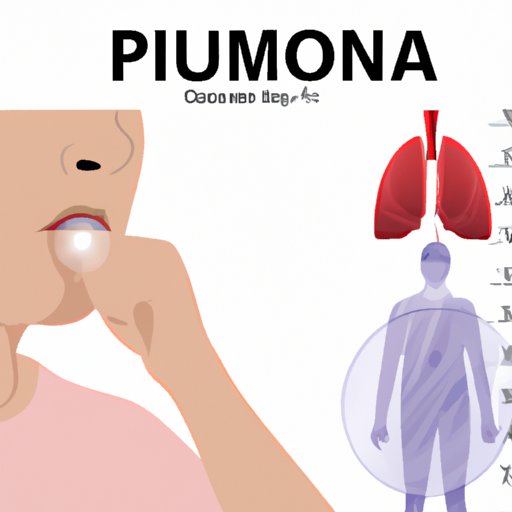
Introduction
Pneumonia is a potentially serious lung infection that affects millions of people each year. Its symptoms, which include coughing, chest pain, and fever, can range from mild to severe. Knowing how to identify these symptoms is crucial to catching pneumonia early and avoiding complications.
Symptom Checker
If you are concerned about pneumonia, it is important to know its symptoms. Some of the most common symptoms include:
- Chest pain when breathing or coughing
- Cough that produces phlegm
- Fatigue
- Shortness of breath
- Fever or chills
However, there are also lesser-known symptoms that can indicate pneumonia. These include:
- Headache
- Sweating
- Muscle aches
- Nausea or vomiting
- Confusion (particularly in older adults)
The type of pneumonia that you have may affect which symptoms you experience. For instance, bacterial pneumonia may cause a high fever, while viral pneumonia may cause a dry cough.
Self-Check Guide
While only a healthcare provider can diagnose pneumonia, there are steps you can take to assess your symptoms and identify your risk. Follow these steps:
- Assess your symptoms: Consider how frequently you cough and whether you are producing any phlegm. Evaluate whether you have shortness of breath and if you have a fever or chills.
- Evaluate your risk: Factors such as age, smoking, and weakened immune systems can increase your risk of developing pneumonia. Consider whether you fall into any of these categories.
- Seek medical attention: If you are experiencing severe or frequent symptoms, it is important to see a healthcare provider. They can conduct further tests, such as a chest x-ray or blood test, to diagnose pneumonia.
Medical Tests
If you see a healthcare provider for pneumonia, they are likely to conduct a chest x-ray or blood test to confirm a diagnosis. During a chest x-ray, an image of your lungs is taken to identify the areas of inflammation or infection. Blood tests can also be performed to measure the number of white blood cells in your body, which can indicate a bacterial infection.
If your healthcare provider suspects a more severe case of pneumonia, they may conduct further tests such as a sputum test or bronchoscopy. These tests can help to identify the bacteria or virus that caused the infection, which can guide treatment.
If you suspect that you have pneumonia, it is important to seek medical attention promptly. Pneumonia can be serious and can lead to complications without prompt treatment.
Risk Factors
Several factors can increase your risk of developing pneumonia. These include:
- Age: People over the age of 65 are at a higher risk of developing pneumonia, as their immune systems weaken with age.
- Smoking: Smoking weakens the lungs and makes it easier for bacteria or viruses to infect them.
- Weakened immune systems: People with weakened immune systems, such as those with HIV or cancer, are more susceptible to pneumonia.
- Chronic lung disease: People with chronic lung diseases such as asthma or COPD are more susceptible to pneumonia.
- Recent infections: If you have recently had a cold or flu, your lungs may already be weakened, making it easier to develop pneumonia.
If you fall into any of these categories, it is especially important to take preventative measures to avoid contracting pneumonia.
Prevention
Preventing pneumonia is crucial for maintaining respiratory health. Here are some preventative measures you can take:
- Vaccines: Vaccines are available for certain types of pneumonia, such as pneumococcal pneumonia. Talk to your healthcare provider to determine which vaccines may be right for you.
- Hand washing: Frequent hand washing can help prevent the spread of bacteria and viruses that can cause pneumonia.
- Improved air quality: Properly ventilating indoor areas can help to reduce the risk of bacteria and viruses spreading.
- Healthy lifestyle: Eating a healthy diet, exercising regularly, and getting enough sleep can help to strengthen your immune system and reduce your risk of contracting pneumonia.
- Quit smoking: Quitting smoking can significantly reduce the risk of developing pneumonia, as well as other respiratory diseases.
Conclusion
Knowing how to identify the symptoms of pneumonia and understand your risk factors are crucial in preventing this potentially serious lung infection. It is important to seek medical attention promptly if you suspect that you may have pneumonia, as early diagnosis and treatment can help to minimize complications. By taking preventative measures such as vaccinations, practicing good hygiene, and quitting smoking, you can reduce your risk of developing pneumonia and maintain good respiratory health.





